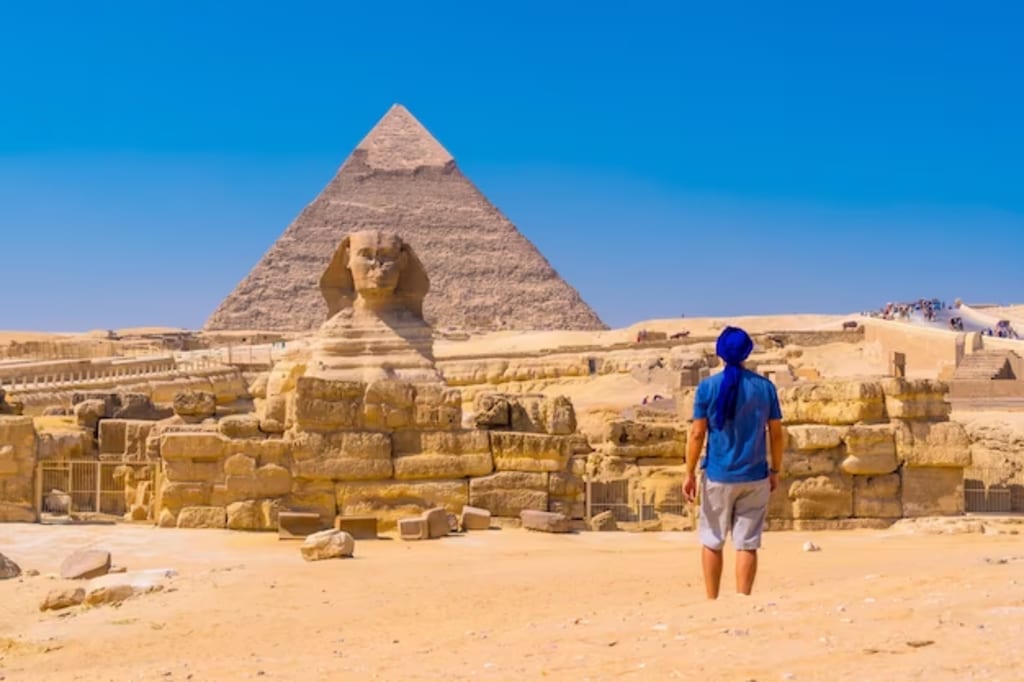Unveiling Egypt's Enigma
The Probable Revelation of the Pyramids' Secrets

In the scalding hot heat of Egypt, you find yourself standing in the town of Sakara, just a few hours after your arrival. Despite the intense temperature, you are captivated by the sight before you—the oldest pyramid in Egypt.
You have been summoned to report on the recent discoveries of ancient Egyptian mysteries. These findings have been unearthed after a staggering four thousand years, which emphasizes their immense importance. The archaeologists at the site are buzzing with excitement. They firmly believe that they have stumbled upon one of Egypt's oldest complete mummies.
As someone who has only seen mummies in movies like "The Mummy," it's difficult to fathom that you are about to witness one in real life. The past year has been fruitful for Egyptology, with numerous new insights into ancient Egyptian life. Among these discoveries stands the remarkable mummy of a prosperous man named Hakashapis. The mummy is exquisitely preserved and found in a deep shaft adorned with layers of gold leaves.
The symbols present on Hakashapis indicate his significance and wealth. Notably, he wore a band on his head, had a chest bracelet, and was embalmed wearing a tunic. However, the most thrilling aspect of this entire discovery is the finding of the mummy's resting place, sealed with mortar—an ancient Egyptian practice dating back 4,300 years. It almost feels like stepping into a time capsule.
Taking a moment to admire the Pyramid of Jose in Sakara, you observe its six-tier, four-sided structure. This remarkable edifice is the earliest stone building in Egypt. It was also here in Sakara that archaeologists found the earliest recordings of Egyptian writing, known as The Pyramid Texts.
These hieroglyphic texts were meticulously carved on the walls of pyramids during Egypt's Old Kingdom, spanning from approximately 2575 BCE to 2130 BCE. Amidst the intriguing discussions among your archaeologist companions, a heated debate ensues regarding a groundbreaking discovery—the first-ever pregnant mummy.
Despite our extensive knowledge of mummification practices, we continue to make discoveries that unveil new aspects of ancient Egyptian life. It took a considerable amount of time for someone to realize that this particular mummy was pregnant because she had been placed in a coffin intended for a male. Historians explain that during the 19th century, traders often mixed up coffins to meet the demands of buyers. This entailed opening them and swapping mummies, leading to unforeseen surprises.
The excitement among your friends is palpable, as this latest mummy finding has the potential to shed light on maternity practices in ancient Egypt. Remarkably little is known about this aspect of their culture, making this discovery all the more significant.
Now, let's delve into a quick round of true or false to debunk a few myths surrounding mummies. Are you ready?
True or false: Mummification recipes varied across Egypt? The answer is 100% true. Archaeologists have uncovered evidence that mummification techniques differed among cities and even varied across different time periods. It's as if some ancient Egyptians had forgotten the practices of their ancestors and had to rediscover them anew. Furthermore, in wealthier cities like Thebes (modern-day Luxor), residents had access to the latest mummification materials. However, in remote areas distant from trade networks, these resources were scarce, forcing them to employ whatever materials were readily available to them.
Here's another intriguing tidbit about mummies: Did Egyptians upcycle coffins? It may be difficult to believe, but it's true. If you thought upcycling was a modern concept, think again—our ancient Egyptian friends were ahead of the game. Wood, the primary material for coffins, was both scarce and expensive. A high-quality casket could cost as much as five goats or 250 loaves of bread.
To save time and money, many embalmers resorted to a rather daring act. They would sneak into pyramids and steal caskets that were already in use.
Now, let's shift our focus to Cairo, where you are ready to visit the Great Pyramids of Giza. The world of Egyptology has been abuzz with excitement ever since scientists uncovered a deeply concealed secret within Khufu's pyramid—or should I say, a well-hidden tunnel. Some claim that this discovery ranks among the most important ones of the 21st century. But why is it so significant? Well, it may hold the key to unraveling the mystery of how the ancient Egyptians constructed the iconic pyramids of Giza.
Until now, there has been limited evidence regarding how the Egyptians managed to maneuver such incredibly heavy limestone blocks. Speculation has ranged from theories involving extraterrestrial assistance to the use of ramps. The earliest hypothesis on the construction methods of the pyramids comes from Herodotus, a Greek scholar from 450 BCE. He proposed that the Pyramids of Giza were initially built as stepped structures and later had their edges smoothed. However, modern-day Egyptologists do not consider Herodotus's account as accurate, and they have put forth alternative conjectures.
Among these theories is the internal ramp and big void theory. For years, architects have discussed the existence of a significant void at the center of the Khufu pyramid, yet its true nature remained uncertain. However, recent advancements in infrared technology, employed by the Scan Pyramids project, shed light on this mystery, revealing the presence of an internal ramp.
If this theory holds true, it suggests that the Egyptians may have utilized an external side ramp on the south side of the pyramid in conjunction with a spiraling internal ramp. These ramps would have served as scaffolding, aiding in the transportation of heavy stone blocks. The internal ramp can be envisioned as a counterweight tool, similar to a modern-day elevator.
Each moment of this journey seems to unveil more fascinating revelations. However, there are still mysteries yet to be unraveled.
Now, here's a thought: Would you believe me if I told you that ancient Egyptians invented robots? Well, that statement isn't entirely accurate. While they excelled in fields such as astronomy, mathematics, and engineering, they also managed to incorporate an eccentric invention into their repertoire—an automated deity. Allow me to introduce Hathor. Scientists named her thus because she was likely built to represent the real Hathor, an ancient Egyptian symbol associated with motherhood, music, and singing.
This wooden statue had resided in the Metropolitan Museum of Art for years before its secret was discovered. Through the assistance of an x-ray machine, specialists revealed a hidden mechanical operating system within. A pulley-like axis connects the statue's shoulder to her left leg. As the system rotates, the statue's hand is raised and lowered.
Let us pause for a moment to appreciate the sheer marvel of this creation, crafted over 3000 years ago. Its resemblance to an invention from the 19th century CE is truly mind-boggling.
Lastly, on your exploration list is the Sphinx. But hold on, I'm not referring to the Great Sphinx of Giza. Instead, let me introduce you to a smaller and cheerier counterpart—the Smiling Sphinx. Sporting a gentle smile and even two dimples, this good-natured statue was uncovered during excavations at the Dendera Temple. Unlike its larger counterpart, which is believed to have been constructed around 4500 years ago, this little sphinx is thought to be relatively more modern.
In traditional ancient Egyptian culture, sphinxes were erected as symbols of royalty and power. Archaeologists have even discovered traces of red and yellow pigments on the face of this sphinx. While the Great Sphinx is commonly believed to represent Pharaoh Khafra, the identity of this smaller statue remains somewhat uncertain. However, experts note that it bears a striking resemblance to the face of Roman Emperor Claudius.
Throughout its over three thousand years of existence, ancient Egyptian society came under Roman rule for more than 600 years, spanning from 30 BCE to around 642 CE. Interestingly, it is rumored that many Roman emperors never visited the ancient Egyptian cities. Could the construction of this sphinx be an homage to one of them? While we can't be certain at this point, it certainly leaves room for speculation.
As you conclude your journey, I hope you return home inspired by these remarkable discoveries. Who knows, perhaps you'll embark on your own quest to uncover ancient mysteries.
About the Creator
Samantha Pienaar
I'm Sam, a beach-loving South African writer from Mossel Bay. Mountains make me the happiest. Mom to a mischievous 4-year-old boy who loves the outdoors. I love to write about facts and mysteries. Let's explore the unknown together!





Comments
There are no comments for this story
Be the first to respond and start the conversation.